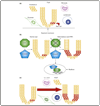Colon cancer stem cells: implications for prevention and therapy
- PMID: 18929507
- PMCID: PMC2789402
- DOI: 10.1016/j.molmed.2008.09.005
Colon cancer stem cells: implications for prevention and therapy
Abstract
The recent identification of colon cancer tumor-initiating cells adds further support to the cancer stem cell hypothesis. Ongoing basic and translational research efforts are aimed at gaining an increased understanding of the biology of these cells, as well as methods of targeting them. In addition, the relationship between colon carcinogenesis and inflammatory conditions, such as longstanding colitis and inherited syndromes, might be linked to the effect of the processes on stem cells in the colon. This review summarizes current literature on colon cancer stem cells and proposes strategies aimed at targeting these cells for colon cancer prevention and therapy.
Figures



Similar articles
-
Inflammation and colon cancer.Gastroenterology. 2010 Jun;138(6):2101-2114.e5. doi: 10.1053/j.gastro.2010.01.058. Gastroenterology. 2010. PMID: 20420949 Review.
-
Supplementation with phytoestrogens and insoluble fibers reduces intestinal carcinogenesis and restores ER-β expression in Apc-driven colorectal carcinogenesis.Eur J Cancer Prev. 2020 Jan;29(1):27-35. doi: 10.1097/CEJ.0000000000000542. Eur J Cancer Prev. 2020. PMID: 31651566
-
Human colon cancer stem cells: a new paradigm in gastrointestinal oncology.J Clin Oncol. 2008 Jun 10;26(17):2828-38. doi: 10.1200/JCO.2008.17.6941. J Clin Oncol. 2008. PMID: 18539961 Review.
-
Hereditary and familial colon cancer.Gastroenterology. 2010 Jun;138(6):2044-58. doi: 10.1053/j.gastro.2010.01.054. Gastroenterology. 2010. PMID: 20420945 Free PMC article. Review.
-
Inflammatory bowel disease and inflammation-associated colon cancer: partners in crime.Curr Drug Targets. 2008 May;9(5):360. doi: 10.2174/138945008784221134. Curr Drug Targets. 2008. PMID: 18473762 No abstract available.
Cited by
-
CD133 expression is not an independent prognostic factor in stage II and III colorectal cancer but may predict the better outcome in patients with adjuvant therapy.BMC Cancer. 2013 Mar 28;13:166. doi: 10.1186/1471-2407-13-166. BMC Cancer. 2013. PMID: 23537343 Free PMC article.
-
Differences and Similarities between Colorectal Cancer Cells and Colorectal Cancer Stem Cells: Molecular Insights and Implications.ACS Omega. 2023 Aug 9;8(33):30145-30157. doi: 10.1021/acsomega.3c02681. eCollection 2023 Aug 22. ACS Omega. 2023. PMID: 37636966 Free PMC article.
-
Ascl2 activation by YAP1/KLF5 ensures the self-renewability of colon cancer progenitor cells.Oncotarget. 2017 Nov 27;8(65):109301-109318. doi: 10.18632/oncotarget.22673. eCollection 2017 Dec 12. Oncotarget. 2017. PMID: 29312609 Free PMC article.
-
Endothelial progenitor cells: current issues on characterization and challenging clinical applications.Stem Cell Rev Rep. 2012 Sep;8(3):926-39. doi: 10.1007/s12015-011-9332-9. Stem Cell Rev Rep. 2012. PMID: 22095429 Review.
-
c-Myc maintains the self-renewal and chemoresistance properties of colon cancer stem cells.Oncol Lett. 2019 May;17(5):4487-4493. doi: 10.3892/ol.2019.10081. Epub 2019 Feb 28. Oncol Lett. 2019. PMID: 30944638 Free PMC article.
References
-
- Al-Hajj M, Clarke MF. Self-renewal and solid tumor stem cells. Oncogene. 2004;23:7274–7282. - PubMed
-
- Wicha MS, et al. Cancer stem cells: an old idea – a paradigm shift. Cancer Res. 2006;66:1883–1890. - PubMed
-
- Bonnet D, Dick JE. Human acute myeloid leukemia is organized as a hierarchy that originates from a primitive hematopoietic cell. Nat. Med. 1997;3:730–737. - PubMed
-
- Kiel MJ, et al. SLAM family receptors distinguish hematopoietic stem and progenitor cells and reveal endothelial niches for stem cells. Cell. 2005;121:1109–1121. - PubMed
Publication types
MeSH terms
Grants and funding
LinkOut - more resources
Full Text Sources
Other Literature Sources

